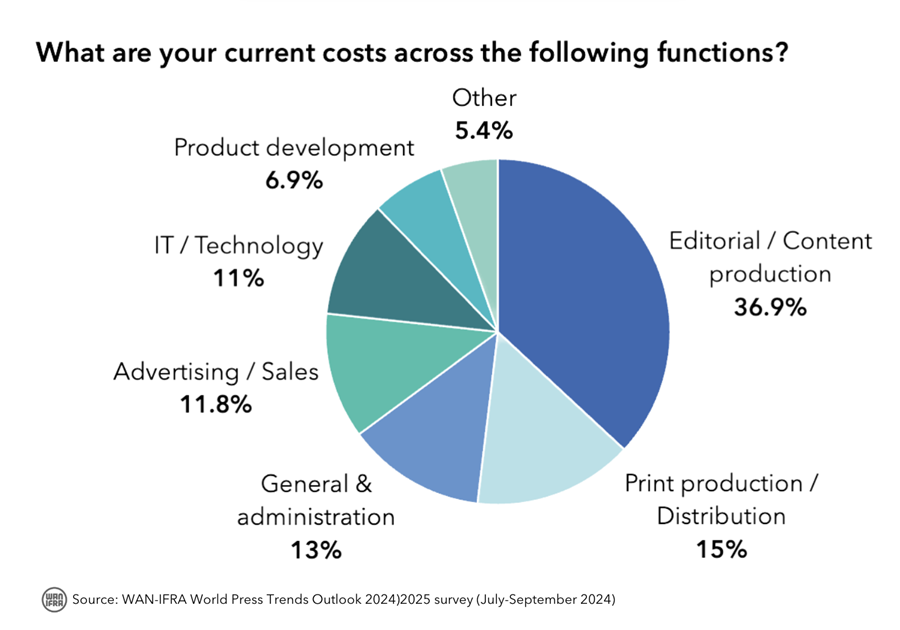 The new WAN-IFRA study marks a milestone as news publishers’ revenue structures become more diversified and less reliant on traditional print sources. For the first time in our research, print circulation and advertising revenues account for less than half of respondents' total revenues.
The new WAN-IFRA study marks a milestone as news publishers’ revenue structures become more diversified and less reliant on traditional print sources. For the first time in our research, print circulation and advertising revenues account for less than half of respondents' total revenues.
The print circulation and advertising revenues decline underscores a major shift in the industry, as publishers increasingly tap into digital and alternative revenue streams to stabilise their businesses in a rapidly changing media landscape.
The findings of the latest World Press Trends Outlook report are based on insights from over 240 senior media executives across 85 countries, providing a global snapshot of the trends shaping the future of publishing.
The full World Press Trends Outlook 2024-2025 report is available for download exclusively for WAN-IFRA members in our Knowledge Hub. (If you are not a member and interested in the report or joining WAN-IFRA, please contact us.)
The revenue structure is evening out
Although print continues to decline as a proportion of total revenue, it is still the largest source of income for our survey respondents. On average, print circulation and advertising together account for almost 45% of respondents’ revenues. This is the first time in our research that this figure has fallen below 50%.
Growth in other areas is at least partly compensating for the losses in print. The average revenue from digital activities is now more than 30% of total revenue, up about 7 percentage points since last year. Digital circulation and digital advertising revenues contribute equally to our respondents’ bottom lines.
“Other” revenue sources (those not related to circulation or advertising) also show significant growth. They now account for 23.8%, an increase of 5 percentage points since last year. It is also worth noting that, on average, “other” revenue sources now bring in as much revenue as print circulation.
Events remain a revenue driver
Looking more closely at the “other” revenue category, we see that events continue to play an important role for publishers looking to diversify their revenues. 29% of our respondents cite events (in-person and online) as a significant additional revenue stream for them.
Beyond events, the data shows that publishers are experimenting with a wide range of activities to create new revenue sources. Among these, grant funding has become an important (though still relatively small) source of revenue after events for the second year running. Many publishers are also generating significant income from business services.
The results also suggest that publishers’ efforts to build meaningful revenue from various forms of membership offerings are bearing fruit, with 13% of respondents saying that this is now an important source of revenue for them (up from 5% last year).
Increased editorial spend in line with audience-first strategies
As publishers continue to transform their businesses and operations to better engage their audiences, with many adopting various types of audiences-first and user-needs approaches, investment in the newsroom has become a top priority for many of them.
Editorial and content production costs now account for almost 37% of respondents’ average total costs (up almost 9 percentage points on last year).
Meanwhile, print production costs continue to fall as publishers streamline their print logistics and some reduce their print runs. Print costs are now 15% of total costs, down from 17.8% last year.
Our respondents also told us that they spent less on product development last year. In 2023, this activity accounted for 12.8% of their company’s costs, but in 2024 this figure fell to 6.9%. This may be at least partly due to many publishers refocusing on maintaining and developing existing products rather than building new ones.
Media-tech relationships shift with focus on GenAI firms
As the dynamics between publishers and tech platforms continue to evolve, and the tech sector faces moderate disruption from the rise of AI, we introduced a new question this year to gain a more nuanced understanding of how relationships with various types of tech firms are changing.
Generative AI platforms emerged as the sector with which our respondents said their relationships had improved the most. This is a particularly interesting top-line result, given that the media industry is seemingly somewhat divided on how to engage with this emerging segment of the tech industry.
In addition to AI companies, relationships with messaging and video platforms have improved the most. For the former, this is likely to be in the context of publishers increasingly focusing on direct communication tools (with some perhaps shifting their focus away from social media). Meanwhile, video’s position here is in line with another question in our survey, where video emerged as an important area for publishers to invest in.































































































